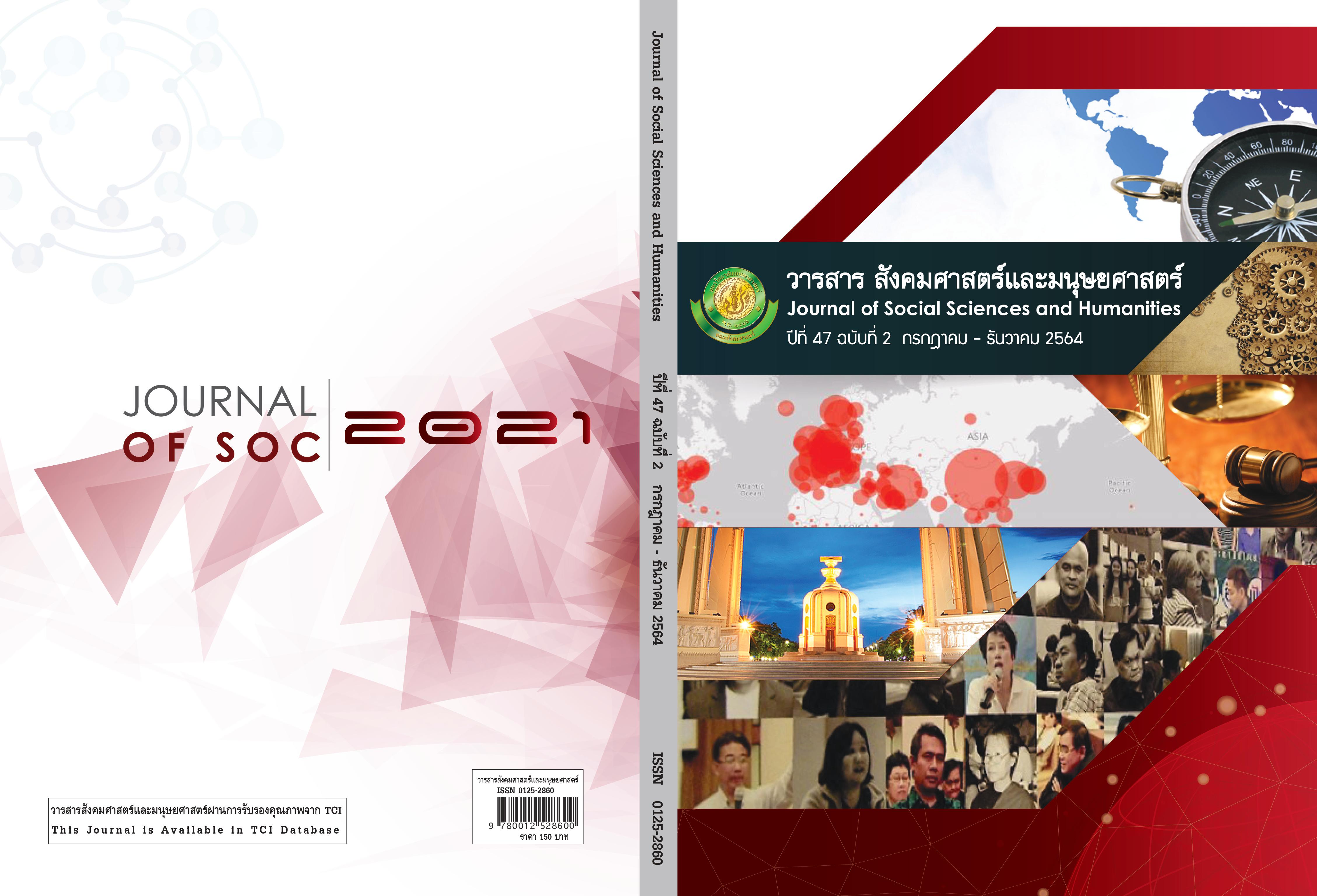สถานภาพองค์ความรู้ของการสื่อสารปฏิสัมพันธ์แบบกึ่งมีส่วนร่วมทางสังคม
Main Article Content
บทคัดย่อ
การวิจัยนี้มีวัตถุประสงค์เพื่อศึกษาสถานภาพองค์ความรู้งานวิจัยทางด้านการสื่อสารที่ศึกษาประเด็นปัญหาเกี่ยวข้องกับการสื่อสารปฏิสัมพันธ์แบบกึ่งมีส่วนร่วมทางสังคม ในช่วงปี 1995 – 2020 ภายใต้บริบททางสังคมและเทคโนโลยีทางการสื่อสารที่เปลี่ยนแปลงไป โดยเป็นการสังเคราะห์งานวิจัยโดยใช้การวิเคราะห์อภิมาน ผลการวิจัยพบว่า งานวิจัยทางด้านการสื่อสารปฏิสัมพันธ์แบบกึ่งมีส่วนร่วมทางสังคมที่มีการเผยแพรในช่วงระยะเวลา 25 ปี โดยส่วนใหญ่ใช้ระเบียบวิธีการวิจัยเชิงปริมาณ วิธีการวิจัยแบบผสมผสานวิธี และวิธีการวิจัยการวิจัยเชิงคุณภาพ ตามลำดับ โดยสามารถแบ่งกลุ่มองค์ความรู้ได้เป็น 2 กลุ่ม คือ (1) กลุ่มงานวิจัยด้านปฏิสัมพันธ์แบบกึ่งมีส่วนร่วมทางสังคมประเภทสื่อเก่า จำนวน 3 ประเภท ได้แก่ ด้านการสื่อสารเพื่อความ ด้านการสื่อสารการเมือง และด้านการสื่อสารสุขภาพ และ (2) กลุ่มงานวิจัยด้านปฏิสัมพันธ์แบบกึ่งมีส่วนร่วมทางสังคมประเภทสื่อใหม่ จำนวน 2 ประเภท ได้แก่ การสื่อสารในสื่อใหม่และสื่อดิจิทัล และการสื่อสารเพื่อธุรกิจ ตามลำดับ
สถานภาพองค์ความรู้ของการสื่อสารปฏิสัมพันธ์แบบกึ่งมีส่วนร่วมทางสังคม จะทำให้เข้าใจและมองเห็นภาพปรากฎการณ์ทางการสื่อสารที่สามารถนำเอาหลักการของทฤษฎีมาปรับประยุกต์ใช้ได้ในทุกแง่มุมของสังคม รวมไปถึงค้นหาคำตอบของปรากฏการณ์ทางการสื่อสาร ขับเคลื่อนสังคมได้อย่างมีประสิทธิภาพต่อไป
Article Details
เอกสารอ้างอิง
เณริศา ชัยศุภมงคลลาภ. (2020). ความสำเร็จของละครโทรทัศน์กับการสร้างปฏิสัมพันธ์ทางสังคมกึ่งความจริง กรณีศึกษา ละครโทรทัศน์บุพเพสันนิวาส. วารสารนิเทศศาสตร์ธุรกิจบัณฑิตย์, 14(1), 158-199.
Auter, P. J., & Palmgreen, P. (2000). Development and validation of a parasocial interaction measure: The audience personal interaction scale. Communication Research Reports, 17(1), 79-89.
Aytulun, G., & Sunai, A. B. (2020). Parasocial Interaction with Media Characters. Psikiyatride Guncel Yaklasimlar, 12(4), 494-506.
Brown, W. J. & Basil, M. D. (1995). Media Celebrities and Public Health: Responses to Magic Johnson's HIV Disclosure and Its Impact on AIDS Risk and High risk Behaviors. Health Communication Journal, 7(4), 345-370.
Hartmann, T., & Goldhoorn, C. H. (2010). Wohl revisited: Exploring viewer’s experience of parasocial interactions. In Annual meeting of the International Communication Association.
Horton, D. & Wohl R.R, (1956). Mass communication and parasocial interaction : Observation on intimacy at a distance. Psychiatry, 19(3), 215-229.
Koenig, F., & Lessan, G. (1985). Viewers' relationship to television personalities. Psychological Reports, 57(1), 263-266.
Lee E. J. & Youn Oh S., (2012). To Personalize or Depersonalize When and How Politicians Personalized Tweets Affect the Public’s Reactions. Journal of Communication, 62, 932-949.
Levy, M. R. (1979). Watching TV news as parasocial interaction. Journal of Broadcasting, 23(1), 177-187.
Lim, C. M. & Kim, Y. (2011). Older Consumers’TV Home Shopping:Loneliness, Parasocial Interaction, and Perceived Convenience. Psychology & Marketing, 28(8), 763–78.
Lueck, J. A. (2015). Friend-zone with benefits: The parasocial advertising. Journal of Marketing Communications, 21(2), 91-109.
Paravati, E., Naidu, E., Gabriel, S. & Wiedemann, C. (2019). More Than Just a Tweet: The Unconscious Impact of Forming Parasocial Relationships Through Social Media. Psychology of Consciousness: Theory. Research, and Practice, 1-16. doi:10.1037/cns0000214
Pitout, M. (1998). Reception analysis: a qualitative investigation of the parasocial and social dimensions of soap opera viewing.
Rubin, A. M., Perse, E. M., & Powell, R. A. (1985). Loneliness, parasocial interaction, and local television news viewing. Human communication research, 12(2),
155-180.
Stever, G. S., & Lawson, K. (2013). Twitter as a way for celebrities to communicate with fans: Implications for the study of parasocial interaction. North American journal of psychology, 15(2).
Xiang, L., Zheng, X., Lee, M. K., & Zhao, D. (2016). Exploring consumers’ impulse buying behavior on social commerce platform: The role of parasocial interaction. International journal of information management, 36(3), 333-347.
Zaheer, L. (2019). Parasocial Interaction and Television Viewers in Pakistan. Journal of Behavioural Sciences, 29(1).


